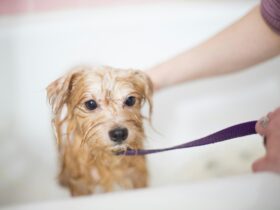Introduction
Ringworm, despite its misleading name, is not a worm but a fungal infection that affects the skin, hair, and nails of dogs. This highly contagious infection can spread quickly between animals and even to humans. Understanding how to identify, treat, and prevent ringworm in your dog is crucial for maintaining their overall health and preventing the spread of this infection.
What is Ringworm?
Ringworm, scientifically known as dermatophytosis, is caused by a group of fungi called dermatophytes. These fungi feed on keratin, the protein found in the outer layer of skin, hair, and nails. Ringworm typically appears as circular, scaly patches of hair loss, although the appearance can vary.
Signs and Symptoms of Ringworm in Dogs
Detecting ringworm in its early stages is key to preventing it from spreading. Here are some common signs and symptoms:
- Circular Patches of Hair Loss: The most recognizable sign of ringworm is circular areas of hair loss with a red, scaly border.
- Itching and Scratching: Dogs with ringworm may scratch more frequently, causing further irritation and spreading the infection.
- Red, Inflamed Skin: The affected areas might appear red and inflamed.
- Scaly or Crusty Skin: The infection can cause the skin to become dry, scaly, or crusty.
- Brittle or Broken Hair: Ringworm weakens the hair, causing it to break easily.
- Nail Bed Infections: In some cases, ringworm can affect a dog’s nails, leading to brittleness and discoloration.
Diagnosing Ringworm in Dogs
If you suspect your dog has ringworm, it’s essential to consult a veterinarian for a proper diagnosis. Diagnosis may involve:
- Wood’s Lamp Examination: A special ultraviolet lamp can sometimes detect ringworm, as the fungi may glow under the light.
- Microscopic Examination: A vet may take a sample of hair or skin scrapings to examine under a microscope for fungal spores.
- Fungal Culture: This is the most reliable method where a sample is placed in a culture medium to see if the fungi grow.
How to Treat Ringworm in Dogs
Treating ringworm in dogs requires a combination of topical and systemic therapies. Depending on the severity of the infection, your vet may recommend one or more of the following treatments:
- Topical Antifungal Treatments:
- Medicated Shampoos and Rinses: Regular bathing with medicated shampoos containing miconazole or chlorhexidine can help eliminate the fungi from the skin.
- Antifungal Creams or Ointments: Applying creams or ointments directly to the affected areas can treat localized infections.
- Oral Antifungal Medications:
- Griseofulvin: Commonly prescribed for severe cases, griseofulvin is an oral medication that helps to eliminate the fungi from within.
- Itraconazole or Terbinafine: These are alternatives to griseofulvin and are also effective against ringworm.
- Environmental Decontamination:
- Cleaning and Disinfecting: Ringworm spores can survive in the environment for a long time, so it’s crucial to clean and disinfect your dog’s living area, bedding, toys, and grooming tools.
- Vacuuming: Regularly vacuuming your home, especially carpets and upholstery, can help remove any fungal spores.
- Isolation:
- Limit Contact: To prevent spreading ringworm to other pets or humans, it’s essential to limit your infected dog’s contact with others until the infection has cleared.
- Regular Vet Check-Ups:
- Follow-Up Visits: Your vet may schedule follow-up appointments to monitor your dog’s progress and adjust treatment if necessary.
How to Prevent Ringworm in Dogs
Preventing ringworm is all about maintaining good hygiene and minimizing exposure to the fungi. Here are some preventive measures:
- Regular Grooming:
- Bathing: Regular bathing with antifungal shampoos can help prevent ringworm, especially if your dog is frequently exposed to other animals.
- Brushing: Regular brushing helps detect skin abnormalities early and keeps your dog’s coat in good condition.
- Clean Living Environment:
- Regular Cleaning: Keep your dog’s living area clean and dry to reduce the risk of fungal growth.
- Disinfecting: Regularly disinfect your dog’s bedding, toys, and grooming tools.
- Minimize Exposure:
- Avoid Contact with Infected Animals: If you know a dog has ringworm, avoid letting your dog interact with them.
- Caution in High-Risk Areas: Be cautious in places where animals congregate, such as dog parks, kennels, and grooming salons, as these are common areas for the spread of ringworm.
- Regular Vet Visits:
- Routine Check-Ups: Regular veterinary visits can help catch infections early and ensure your dog’s overall health.
- Skin Examinations: During routine check-ups, ask your vet to examine your dog’s skin for any signs of infection.
- Boost Immune Health:
- Proper Nutrition: A healthy diet supports a strong immune system, which can help your dog fight off infections like ringworm.
- Regular Exercise: Keeping your dog fit and active boosts overall health and resilience against infections.
Conclusion
Ringworm in dogs is a manageable condition with proper treatment and preventive care. Early detection, consistent treatment, and maintaining a clean environment are key to keeping your dog healthy and free from this contagious infection. By following the guidelines outlined in this blog, you can help your dog recover quickly and prevent future occurrences of ringworm.











Leave a Reply